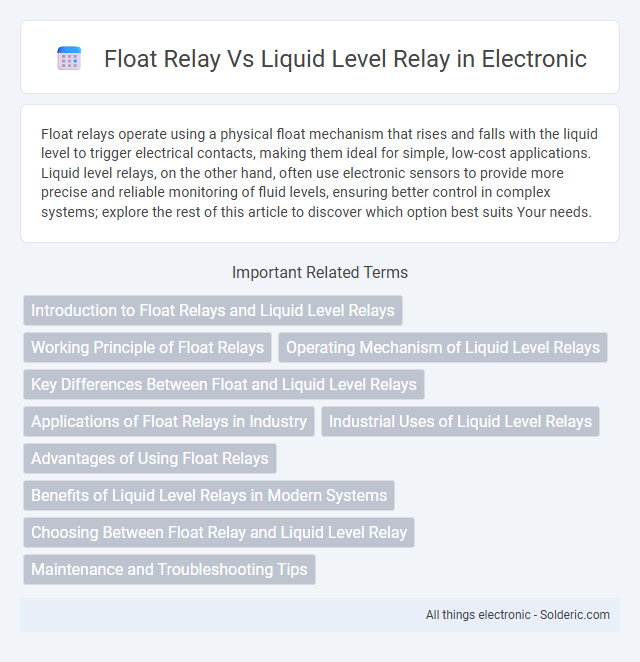Float relays operate using a physical float mechanism that rises and falls with the liquid level to trigger electrical contacts, making them ideal for simple, low-cost applications. Liquid level relays, on the other hand, often use electronic sensors to provide more precise and reliable monitoring of fluid levels, ensuring better control in complex systems; explore the rest of this article to discover which option best suits Your needs.
Comparison Table
| Feature | Float Relay | Liquid Level Relay |
|---|---|---|
| Operating Principle | Uses a floating device to detect liquid level changes. | Employs electrical conductance or capacitance to sense liquid levels. |
| Type | Mechanical. | Electrical. |
| Installation | Mounted inside or on tank surface with a float arm. | Mounted externally or internally with electrodes or sensors. |
| Accuracy | Moderate accuracy, influenced by liquid turbulence. | High accuracy with precise level detection. |
| Maintenance | Requires periodic cleaning of float mechanism. | Minimal maintenance, sensor cleaning recommended. |
| Cost | Generally low cost. | Moderate to high cost depending on sensor type. |
| Applications | Water tanks, sump pumps, general liquid level control. | Chemical processing, industrial tanks, hazardous liquids. |
| Reliability | Reliable in clean liquids but affected by debris. | Reliable in various liquid types including corrosive fluids. |
Introduction to Float Relays and Liquid Level Relays
Float relays operate using a buoyant float that rises or falls with the liquid level, triggering mechanical switches to control pumps or alarms. Liquid level relays detect fluid levels through electrical conductivity or pressure sensors, offering precise and non-mechanical monitoring. Both devices provide crucial automation for fluid management systems by ensuring safe and efficient liquid level control in applications like water tanks, sewage systems, and industrial processes.
Working Principle of Float Relays
Float relays operate based on the buoyancy principle, where a floating component rises or falls with the liquid level, triggering a mechanical or electrical switch to control pumps or alarms. Unlike liquid level relays that detect changes through conductivity or capacitance, float relays provide direct physical movement feedback, ensuring reliable operation in varying fluid conditions. Your system benefits from precise and consistent monitoring using float relays for accurate liquid level control.
Operating Mechanism of Liquid Level Relays
Liquid level relays operate using sensing elements that detect changes in fluid height through electrical signals, often employing float switches, conductive probes, or ultrasonic sensors. Unlike float relays that rely solely on mechanical movement of a buoyant float, liquid level relays convert level changes into electrical outputs to control pumps or alarms accurately. Your system benefits from precise and reliable liquid level monitoring with minimal mechanical wear, making liquid level relays ideal for automated fluid management.
Key Differences Between Float and Liquid Level Relays
Float relays use a physical float mechanism that rises or falls with the liquid level to open or close electrical contacts, providing simple and reliable liquid level detection. Liquid level relays, often electronic or capacitive sensors, detect the liquid level without moving parts by sensing changes in conductivity or capacitance, offering higher precision and less mechanical wear. Your choice between the two depends on the application's accuracy requirements, maintenance preferences, and environmental conditions.
Applications of Float Relays in Industry
Float relays are extensively used in industrial applications for precise liquid level control in tanks, reservoirs, and sump pumps, ensuring reliable operation of water treatment plants and chemical processing units. These relays effectively monitor and regulate fluids in HVAC systems, preventing overflow or dry-run conditions by activating alarms or control circuits. Their robust design allows seamless integration in wastewater management and boiler feedwater systems, where maintaining consistent fluid levels is critical for operational safety and efficiency.
Industrial Uses of Liquid Level Relays
Liquid level relays are widely used in industrial applications for precise monitoring and control of fluid levels in tanks, boilers, and reservoirs to prevent overflow or dry running. Unlike float relays, liquid level relays use electronic sensors to detect levels, offering higher accuracy and reliability in harsh environments with corrosive or volatile liquids. You can rely on liquid level relays in industries such as chemical processing, water treatment, and oil refining to ensure safe and efficient operations.
Advantages of Using Float Relays
Float relays offer precise and reliable liquid level control by mechanically detecting liquid presence without requiring external power sources, reducing operational costs. Their simple design ensures low maintenance and high durability, making them ideal for harsh industrial environments. Float relays provide quick response times and compatibility with various liquid types, enhancing overall system efficiency and safety.
Benefits of Liquid Level Relays in Modern Systems
Liquid level relays offer enhanced accuracy and reliability compared to float relays, making them ideal for precise liquid monitoring in modern industrial and commercial systems. These relays provide faster response times and require less maintenance due to their solid-state or electronic design, reducing operational downtime. Integration with automated control systems and IoT technology enables real-time liquid level monitoring and remote management, improving efficiency and safety.
Choosing Between Float Relay and Liquid Level Relay
Choosing between a float relay and a liquid level relay depends on the specific application requirements such as accuracy, installation environment, and maintenance needs. Float relays offer reliable mechanical operation ideal for simple, low-cost water level control, while liquid level relays provide precise electronic monitoring suitable for critical industrial processes. Evaluating factors like fluid type, temperature range, and response time ensures the optimal relay selection for effective liquid level management.
Maintenance and Troubleshooting Tips
Float relays require regular inspection to ensure the float moves freely without obstructions or buildup, which can cause inaccurate liquid level detection and relay failure. Liquid level relays often include sensors that may need cleaning to prevent false signals due to sediment or corrosion, and checking wiring connections helps avoid intermittent faults. For your system's reliable operation, test relays periodically and replace damaged components promptly to minimize downtime and maintain precise control.
Float relay vs liquid level relay Infographic

 solderic.com
solderic.com